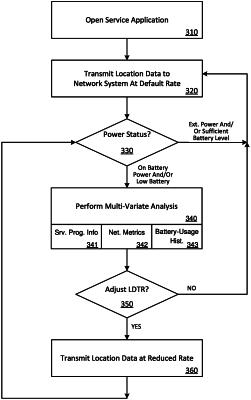| CPC H04W 4/029 (2018.02) [H04W 52/0261 (2013.01); H04L 43/0811 (2013.01)] | 17 Claims |

|
1. A computing device comprising:
a processor; and
memory storing instructions that, when executed by the processor, cause the computing device to:
operate in a default mode to periodically transmit location data of the computing device to a network system;
while operating in the default mode, determine, using a machine-learned model to perform a multi-variate analysis including weighting one or more parameters associated with transmitting the location data, the one or more parameters comprising at least (i) a power status of the computing device and (ii) a connectivity metric of a network connection, wherein the multi-variate analysis is specific to the computing device such that, when the multi-variate analysis is performed on a different computing device, at least one of the one or more weighted parameters for the computing device are different from at least one of the one or more weighted parameters for the different computing device, whether to operate in an alternate power mode to transmit the location data to the network system based, at least in part, on: (i) the power status of the computing device, and (ii) the connectivity metric of the network connection of the computing device; and
in response to determining to operate in the alternate power mode, operate in the alternate power mode to periodically transmit the location data of the computing device to the network system more frequently or less frequently than when operating in the default mode.
|